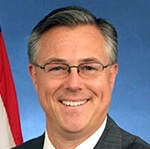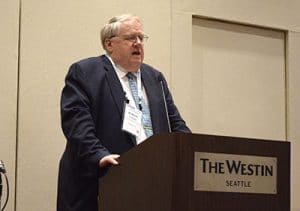An update on the railroad industry’s implementation of positive train control (PTC) will be one of the major topics covered in the next meeting of the Rail Safety Advisory Committee (RSAC) scheduled 9:30 a.m. to 4:30 p.m. Nov. 26, according to a notice published in the Federal Register.
The meeting will be at the National Association of Home Builders, 1201 15th St. NW, Washington, D.C. 20005. Representatives from 29 member organizations, including SMART TD, will convene at the meeting, which is open to the public on a first-come, first-served basis.
The agenda also will include remarks from FRA Administrator Ron Batory and committee reports from the Working Groups for Tourist and Historic Railroads; Track Standards; Passenger Safety; Part 225 Accident Reporting; Train Dispatcher Certification; and Signal Employees Certification and is subject to change, the Federal Register notice stated.
RSAC is a federal advisory committee to the FRA intended to develop railroad safety regulations through a consensus process.
More information about RSAC and a finalized agenda for the meeting will be posted on the RSAC website at least a week in advance of the meeting.
Tag: RSAC
The Federal Railroad Administration (FRA) will have some major shoes to fill with the April 13, 2019, retirement of Robert “Bob” Lauby, the agency’s chief safety officer.
Lauby had served in that capacity for FRA since September 2013. He was a frequent presenter at SMART Transportation Division regional meetings and worked to provide regulatory oversight for rail safety in the United States while overseeing the development and enforcement of safety regulations and programs related to the rail industry.
“Serving as the associate administrator for Railroad Safety and FRA’s chief safety officer is one of the highlights of my career,” Lauby said. “The job has been both challenging and fulfilling.
“Over the years, we grappled with many important issues and have significantly changed the industry for the better.”
Lauby had a hand in several regulatory safety efforts at FRA such as Positive Train Control, conductor certification, training requirements, drug and alcohol testing for maintenance of way employees, roadway worker protection, passenger equipment standards, system safety and others.
Other safety oversight improvements happened as a result of major accidents. Some of the major ones included crude-oil accidents at Lac Megantic, Ontario, Canada; Mount Carbon, W.Va.; and other locations; commuter train accidents at Spuyten Duyvil and Valhalla, N.Y.; and Amtrak passenger train accidents in Philadelphia and Chester, Pa.; Dupont, Wash.; and Cayce, S.C.
“No matter the challenges swirling around him, Bob had safety in mind,” said National Legislative Director John Risch. “He’s been great to work with and one of the most committed, level-headed professionals in the rail industry.”
Lauby said that he treasured any interaction he could have with members of rail labor as these helped to broaden his perspective about whom he was working to protect.
“I always took time to talk to the SMART TD membership to get their complaints, opinions, and perspectives on the latest industry issues,” Lauby said. “I often left enlightened or with a new perspective.
“Railroad managers are experts on what is supposed to happen. SMART TD members are experts on what actually happens. They always know what works and what does not work.”
In his more-than-40-year career, Lauby’s railroad and transit experience included safety, security, accident investigation, project management, project engineering, manufacturing and vehicle maintenance.
He joined the FRA in August 2009 as staff director of its newly established Passenger Rail Division in the agency’s Office of Safety and was later promoted to deputy associate administrator for regulatory and legislative operations at FRA. One of his responsibilities in that role was to oversee the Rail Safety Advisory Committee (RSAC).
Prior to his time at FRA, Lauby was director of the National Transportation Safety Board’s Office of Railroad Safety, overseeing hundreds of rail accident investigations for NTSB and coordinating with our union’s Transportation Safety Team in many investigations. He was NTSB’s representative on RSAC.
“At our regional meetings, I would introduce Bob and tell the troops that Bob was the big gun and can handle all the tough questions, which he always did,” Risch said at a party celebrating Lauby’s retirement in late March.
Lauby said he took his multiple presentations at TD regional meetings, including at the Seattle regional meeting last July, seriously — he felt he owed it to the attendees to give them useful information.
“I looked forward to the meetings each year and spent hours preparing my presentation and preparing for the questions I would get at the end – during the Q and A session,” he said. “I wanted the material I presented to be timely and useful to the membership, and I always tried to include the inside scoop – the stuff nobody else would talk about!”
But the benefits from his visits and interactions went both ways, he said, and showing up at the meetings gave him a fresh perspective on the industry.
“I always enjoyed speaking to the SMART TD membership – both at the Regional Meetings and when they were on their jobs,” Lauby said. “Whenever I traveled by train, I tried to spend time with the train crew or ride the head end to find out the issues of the day.
“I learned more about railroading from the working men and women of the railroad industry than from anyone else.”
Lauby’s departure is leaving a vacancy that FRA will have a difficult time filling, Risch said.
“No one will really fill your shoes because there is no one with the knowledge and experience to do that,” he told Lauby at his retirement party. “You committed your working life to rail safety, you have been a good friend of mine and a good friend to railroad workers everywhere.
“We wish you all the best as you enter this next stage of your life.”
Lauby said his career leaves him with a sense of gratitude.
“I will always be grateful to have had the opportunity to work in the industry I love, in a role where I felt I could make a difference,” Lauby said. “I will miss the thousands of people I interacted with each year. That includes the FRA employees and railroad industry labor and management … all the folks I dealt with at the various RSAC meetings. People are the most important part of any organization and the railroad industry is no different.”
The Federal Railroad Administration (FRA) announced Tuesday, April 9, that the Rail Safety Advisory Committee (RSAC) will meet later this month for the first time since its reinstatement last autumn.
According to a notice published in the Federal Register, RSAC is scheduled to meet 9:30 a.m. to 3:30 p.m. Wednesday and Thursday, April 24 and 25, 2019, at the National Association of Home Builders, National Housing Center, 1201 15th Street NW, Washington, DC 20005.
RSAC is composed of 40 voting representatives from 29 member organizations, including SMART Transportation Division and other rail labor groups, representing various rail industry perspectives.
The meeting’s agenda is scheduled to include opening remarks from FRA Administrator Ron Batory, updates on the industry’s implementation of Positive Train Control and FRA presentations from its Passenger Safety and Tourist and Historic Railroads working groups, the Federal Register notice stated.
Planning and procedures of future RSAC activities also will be on the agenda, which is subject to change.
The meeting is open to the public on a first-come, first-served basis, and is accessible to individuals with disabilities. Persons who wish to submit written comments for RSAC’s consideration during the meeting must submit them no later than Friday, April 19, to ensure transmission to RSAC members prior to the meeting. Comments received after that date and time will be distributed to the members but may not be reviewed prior to the meeting.
Those seeking additional information should contact Kenton Kilgore, RSAC designated federal officer/RSAC coordinator at the FRA Office of Railroad Safety at 202-493-6286; or Larry Woolverton, executive officer of the FRA Office of Railroad Safety at 202-493-6212.
RSAC was rechartered for two years in September 2018 after a period of dormancy. The committee, in existence since 1996, advises the FRA administrator and makes recommendations on matters relating to railroad safety, resulting in a process that allows stakeholders, including labor and industry representatives, to collaborate before proposed rules are submitted. It last met in May 2017.
A notice published in the Federal Register in late September announced that the Railroad Safety Advisory Committee (RSAC) would be rechartered for two years after a period of dormancy.
RSAC advises the administrator of the Federal Railroad Administration (FRA) and makes recommendations on matters relating to railroad safety, resulting in a process that allows stakeholders, including labor and industry representatives, to collaborate before proposed rules are submitted.
The committee consists of 40 representatives from 29 member organizations, including SMART Transportation Division. It last met in May 2017, according to the RSAC website, and has been in existence since 1996.
A notice providing details about the committee’s next meeting has yet to be posted the RSAC site.

The Federal Railroad Administration (FRA) will soon unveil its expectations for railroads to meet the newly extended Dec. 31, 2018, deadline for positive train control (PTC) implementation, FRA Administrator Sarah Feinberg told members of the Railroad Safety Advisory Committee (RSAC) last week.
Feinberg urged railroads not to make the extension their primary focus, but to focus on “getting PTC up and running as soon as possible,” according to a prepared statement of remarks.
“Over the last year, I am sure you have observed that FRA is in a much more aggressive posture on PTC, and everyone should expect for that posture to continue,” Feinberg told the committee, which advises the railroad industry on safety policy.
Read more from Progressive Railroading.

Alternate National Legislative Director Greg Hynes testified Thursday, August 28 at the Federal Railroad Administration’s (FRA) Risk Reduction public hearing.
The FRA published a notice of proposed rulemaking February 27, 2015 requiring certain railroads to develop a Risk Reduction Program (RRP). The Rail Safety Improvement Act of 2008 already requires the development and implementation of railroad safety risk reduction programs.
Risk reduction is a comprehensive, system-oriented approach to safety that: (1.) Determines an operation’s level of risk by identifying and analyzing applicable hazards; and (2.) involves the development of plans to mitigate that risk.
Each RRP is statutorily required to be supported by a risk analysis and a Risk Reduction Program Plan (RRPP), which must include a technology implementation plan and a fatigue management plan.
Below is Hynes’ testimony.
“On April 28, 2015 SMART and six other labor organizations submitted written views on the proposed rulemaking. My testimony will further explain the concerns of SMART.
“I acknowledge that the rail unions agreed to the draft of the risk reduction proposal. However, the proposed rulemaking takes excessive liberty with that tentative agreement. The technical drafting by FRA is not acceptable and we submit it varies from what was approved in the Rail Safety Advisory Committee (RSAC) deliberations.
“I want to reiterate the strong opposition to the Baker Botts study relied upon by FRA to restrict discovery. You should be aware that Baker Botts is a political surrogate for the railroads. The report it submitted reflects this bias. Clearly, the study lacks the objectivity that FRA should have required for an issue so controversial. Its conclusion that the information compiled for the risk reduction plan should be secret is not supported by the statutes it reviewed. FRA needs to recognize that each of the statutes mentioned by Baker Botts limits discovery only in a limited way, and discovery is allowed in every safety statute. The exception is for discovery of governmental documents.
“Our members have voiced great concern that FRA’s proposal here would have a significant negative impact on safety. If a safety hazard exists of which a railroad has knowledge, then the public and railroad employees should not be prevented from knowing such information. Congress has mandated that FRA, in carrying out its duties, shall consider the assignment and maintenance of safety as the highest priority. And it must recognize the clear intent of Congress for the furtherance of the highest degree of safety in railroad transportation. Restricting the public’s access to the railroad’s knowledge of a safety hazard does not comply with the statutory mandate.
“It became clear early in the RSAC working group that FRA was planning to provide the railroads complete protection to keep secret its risk reduction plan. Therefore, it was incumbent upon rail labor to insist that any such information contained therein be compiled “solely” for the risk reduction plan. Any information currently discoverable would continue to be. The problem is that the railroads might attempt to insert many items into the plan and state that they were collected solely for the plan. FRA must clearly specify that such maneuvers would violate the regulation. Also, the labor organizations previously submitted a list of documents that had been discoverable in court proceedings. In order to limit future litigation costs, this list should be restated in the final plan. Otherwise, FRA will be creating a legal nightmare, because the railroads would likely argue in court that almost everything sought was compiled solely for the risk reduction plan.
“Another major concern is that the proposed rulemaking limits the involvement of the collective bargaining representatives in compiling the safety hazards and their mitigation. Unless we are given an equal role, as the railroads to develop the plan many safety hazards likely will be overlooked. The current draft does not comply with the “best efforts and good faith” statutory mandate in development of a railroad’s risk reduction plan. We commend FRA in its explanation of the meaning of best efforts and good faith. However, FRA’s statement in the proposed rulemaking that it will simply “consider” the comments submitted regarding the consultation process requirements when developing the final rule is not acceptable. The workers should be on an equal footing with the railroads in developing the plan. If a railroad does not agree with a union that an issue is a safety hazard, the railroad should be required to show good cause for not including it in the mitigation plan. The railroads must be required to demonstrate substantial grounds not to include an identified safety hazard.
“There are several other points regarding the development of the plan which need to be addressed. FRA has not imposed any time limits upon the industry to consult with the workers or to develop the plan. Rather, the employees are given 60 days notice prior to the consultation. If there are no time limits for completing the plan, then the carriers could drag their feet indefinitely.
“Next, it is not clear why FRA in Appendix B suggests that the railroads should wait one year after publication of the rule to hold substantive consultations. Consultations should begin as soon as possible. Safety delayed is safety denied.
“Another time issue is in section 271.103 (a)(2). The railroads are given 36 months to fully implement the risk–based hazard management plan. If the carriers know the safety problems and how to mitigate them, the plan should be implemented no later than six months after FRA’s approval. There may be minor exceptions only with the approval of the employees.
“In conclusion, in the interests of safety, we strongly encourage FRA to amend the proposed rulemaking in accordance with our suggestions.”

The following are Federal Railroad Administrator Joseph Szabo’s opening remarks to those attending the 50th meeting of the Railroad Safety Advisory Committee (RSAC) in Washington on Oct. 31, 2013.
Today marks the end of a stressful month. The government shutdown forced us to put a lot of important work on hold. And since it ended, we’ve had a lot of catching up to do.
So let me thank my FRA staff for catching up so fast so that the RSAC could meet this week as planned.
As I said at the emergency RSAC meeting two months ago, we have a very important job to do.
The accident in Quebec took 47 lives. And at our last meeting, all of us saw the unforgettable images of a town that was decimated.
Given the depths of the devastation, given the tremendous increase in crude oil and ethanol being moved by rail, and given our shared desire to prevent a similar accident from happening in the United States, we owe the public both decisive action and a thorough re-examination of relevant regulations and industry practices.
We must also acknowledge that, since we last met, there was another accident in Canada – this one involving the derailment of four rail cars carrying crude oil.
The crude oil did not originate in the United States – and the damage was much less severe.
But it still serves as a reminder that we must we must do everything we can to prevent similar accidents from occurring in the United States.
This is why we are here.
FRA’s first decisive action after the accident in Quebec was to issue an Emergency Order. This required railroads to take immediate steps within 30 days to prevent trains on mainline tracks or sidings from moving unintentionally.
And to begin our overall re-examination, we issued a Safety Advisory with our sister agency, the Pipeline and Hazardous Materials Safety Administration.
Our Safety Advisory recommended additional ways railroads can further reduce risk in our complex, interconnected rail system – and through those efforts, further strengthen the safe transportation of passengers and freight, including hazardous materials, by rail.
At our Emergency Meeting, we began an honest discussion about these recommendations. The RSAC also agreed to accept task statements related to train securement, to hazardous materials, and to train crew size.
So let me thank you for your hard work on these tasks over the past three months, and especially those who attended the working group meetings the past three days.
There is no going back. Ensuring continuous safety improvement demands that we stay focused, we meet our April deadline, and we finish the job.
To be clear, we are not here because our rail system is unsafe – or because accidents of trains carrying hazardous materials are widespread.
Our rail system is extremely safe.
As I have said repeatedly, 2012 – by virtually all measures – was the safest year in railroading history, with train accidents down a remarkable 43 percent in 10 years.
And among the millions of annual shipments of hazardous materials by rail, less than a fraction of one percent of these has resulted in any type of release.
But this is exactly why we must remain vigilant.
Being satisfied with the progress made to date is simply not the mindset that has led us – or will continue to lead us – to higher levels of safety.
A new milestone achieved in safety is merely an invitation to do better.
The safety statistics of the MM&A before Lac Megantic did little to show an impending accident.
Yet with a thorough risk analysis it becomes clearer where pockets of risk were evident.
It presents a challenge to go beyond the statistics, to do thorough risk analyses, and to add the safety redundancy that takes away single points of failure.
But, this is how we will achieve the next breakthrough in safety, and get better at addressing accidents before they happen.
This is what we are committed to.
This is why we are here.
The safest year in railroading history did not happen by mistake.
Many of you in this room and many of your predecessors helped guide us there.
And it never would have happened without stringent regulations and enforcement; without extensive industry guidelines, practices, and testing; or without a well-trained and committed workforce.
But the RSAC’s job now is to set aside any assumptions. Your charge here is to look at everything with a fresh set of eyes.
For the tasks related to hazardous materials and securement, this means a thorough reconsideration of existing regulations – and industry practices: from guidelines, to training, and efficiency testing.
And the goal is simple.
We must identify how regulations and practices can be improved. And if there are any gaps, we must find common sense ways to close them.
So far, the industry has shown us it is willing to move forward.
On September 30th, I sent letters to the Association of American Railroads, the American Public Transportation Association, and the American Short Line and Regional Railroad Association. And the letter informed them that we were starting a web page to keep the public informed about their progress in implementing recommendations in the safety advisory.
In the letter, I asked the organizations to summarize the steps their members have taken to address our recommendation. And all three organizations – within weeks – responded with descriptions of their recent actions.
We posted our letters and the responses on the web page. And the industry associations will receive letters from us with additional questions very soon.
Our plan is to keep this page updated so we can have a public, transparent conversation.
Another project dovetailing with the work moving forward in the RSAC is what we’re calling Operation Classification.
This is a joint inspection operation we launched with the Pipeline and Hazardous Materials Safety Administration in the Bakken region to verify that crude oil is being properly classified in accordance with federal regulations.
We are making sure that the testing to determine its classification is being done, while also analyzing the effects of corrosion in tank cars.
Collected samples are still being tested. And our goal, ultimately, is to establish best practices for the classification of hazardous materials.
Like us at the FRA, the Pipeline and Hazardous Materials Safety Administration – as Administrator Cynthia Quarterman said at the emergency meeting – is determined to use all means necessary to prevent a tragedy on par with what happened in Canada here in the United States. And they remain a vital partner for the FRA as the RSAC’s efforts move forward.
It is important to understand that our sister agency writes the regulations governing the safe movement of hazardous material by rail. We in turn enforce them.
And it’s with your input that we’ll recommend to them if current hazardous material regulations need to be revised or expanded.
With securement, the task is very similar – except the regulations are FRA’s.
We are relying on you to thoroughly review both the adequacy of the regulations in place – and particularly how well these regulations are understood and followed. And we are relying on you to help us add more clarity to securement practices, and help us better understand what are truly the most effective practices for securing a train.
We are also asking you to take a hard look at the issue of train crew size.
As we have said from the beginning, FRA believes safety is enhanced through the use of multiple-person crews. And while we want this to continue being a robust conversation that recognizes the nuance of railroading, two days ago Bob made our position very clear: The starting point for our discussion is mandating multiple-person crews.
Now, this does not mean we are seeking to impose a single one-size-fits-all approach.
And as I’ve said before, this cannot be viewed as a job security measure.
So, while we believe that multiple-person crews enhance safety and eliminate risk from our vast rail network, we also believe there are instances in which multiple-person crews may not be necessary.
The starting point for our conversation is to identify what these exceptions should be.
We’re relying on you to help us with this and I believe that no other group is more qualified – or more capable – of identifying the proper exceptions than you.
The public is counting on us to make timely progress.
So, let’s have this conversation and meet the April deadline.
And let’s seize this opportunity to build upon the comprehensive safety framework that made last year the safest in railroading history.
This is why we are here.
Thank you very much.

“Safety is our top priority,” said U.S. Transportation Secretary Anthony Foxx. “While 2012 was the safest year in rail history, we are constantly reviewing our work to ensure the public’s safety on our nation’s rails and value the important input we are receiving from industry stakeholders.”
The RSAC is a technical and policy stakeholder advisory group that makes recommendations to the FRA on rail safety issues, and includes representatives from every facet of the rail industry. The issues discussed at the meeting included the safety requirements contained in FRA Emergency Order No. 28 (EO 28) and the recommendations made in Safety Advisory 2013–06, both issued on Aug. 2.
EO 28 is a mandatory directive to railroads requiring them to undertake a number of immediate actions to ensure that trains transporting hazardous materials (hazmat) are secured and not left unattended. The directive also includes communication requirements. Failure to comply with the emergency order requirements will result in enforcement action.
The safety advisory contains recommendations issued jointly by FRA and the Pipeline and Hazardous Materials Safety Administration (PHMSA) to railroads and hazmat shippers, including requiring railroads to review their crew staffing requirements for transporting hazardous material, conduct system-wide evaluations to identify hazards that may make it more difficult to secure a train or pose other safety risks, and develop procedures to reduce those risks. The advisory served as the agenda for today’s meeting. The implications as well as potential costs and benefits of new or expanded safety requirements and initiatives, including possible new RSAC tasks to implement them, were also discussed.
“Today’s meeting brings together some of the best and brightest minds our industry has to offer in order to tackle issues of paramount importance,” said FRA Administrator Joseph C. Szabo. “The dialogue will serve to build upon the comprehensive regulatory framework we already have in place, and allow us to further enhance safety by eliminating additional risk from the railroad system.”
During the meeting, RSAC members voted to accept four task statements on: appropriate train crew size; requirements for the securement of trains; operational testing for employees to ensure appropriate processes and procedures for securing trains are followed; and hazardous materials issues relating to the identification, classification, operational control and handling of such shipments in transportation. The RSAC will now establish working groups with the necessary expertise to examine each task, gather relevant facts, and develop a range of options. The recommendations of those working groups will be presented to the RSAC by April 2014.
“As greater quantities of hazmat are transported by rail and other modes, the risks increase and we have to make sure our regulations are keeping pace with market and technology forces,” said PHMSA Administrator Cynthia Quarterman. “We have to work together to identify gaps, be willing to acknowledge them and close them.”
Under current U.S. Department of Transportation regulations, freight railroads are required to undertake safety and security risk assessments and implement procedures in order to transport certain hazardous materials, including creating a plan to prevent unauthorized access to rail yards, facilities, and trains carrying hazardous materials. Railroads that carry hazardous materials are required to follow established protocols while en route, and railroad employees are subject to background checks and must complete training. Railroad training programs and operating practices are reviewed and audited by the FRA routinely and are generally designed to be progressive so that as the level of risk increases, so does the level of safety and security required.


